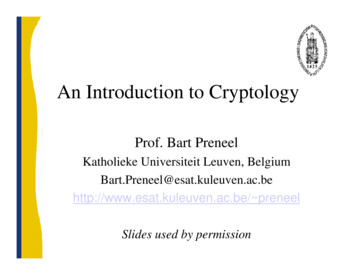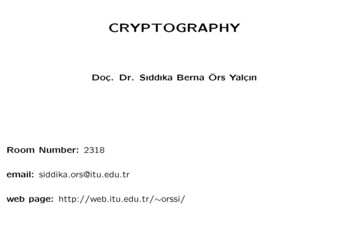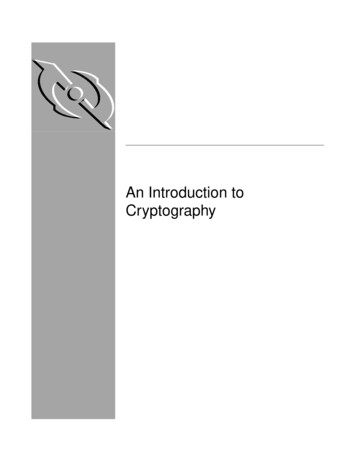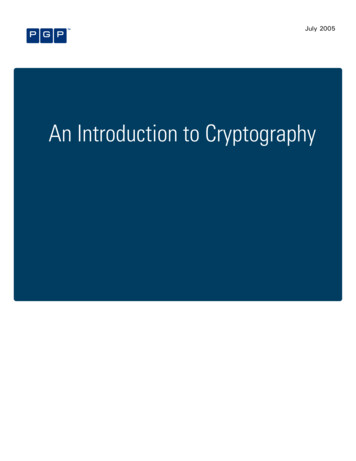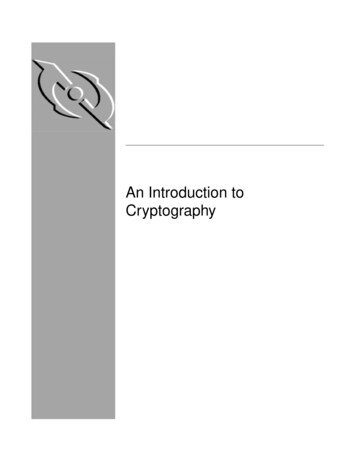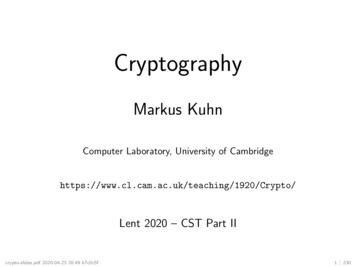
Transcription
Introduction to CryptographyLecture 1Benny PinkasOctober 30, 2012Introduction to Cryptography, Benny Pinkaspage 1
Administrative Details Web ml Grade– Exam 75%, homework 25%Email: benny@pinkas.netGoal: Learn the basics of modern cryptography Method: introductory, applied, precise. October 30, 2012Introduction to Cryptography, Benny Pinkaspage 2
Bibliography Textbooks:–Introduction to Modern Cryptography, by J. Katz and Y.Lindell.–Cryptography Theory and Practice, Second (or third)edition by D. Stinson. (Also, מדריך למידה בעברית של ! )האוניברסיטה הפתוחה October 30, 2012Introduction to Cryptography, Benny Pinkaspage 3
Bibliography Optional reading:–Handbook of Applied Cryptography, by A. Menezes, P.Van Oorschot, S. Vanstone. (Free!)–Applied Cryptography, by B. Schneier.October 30, 2012Introduction to Cryptography, Benny Pinkaspage 4
Probability Theory One of the perquisites of this course is the course“Introduction to probability”–If you haven’t taken that course, it is your responsibility tolearn the relevant material.–You can read Luca Trevisan’s notes on discreteprobability, available athttp://www.cs.berkeley.edu/ luca/notes/notesprob.pdf–Afterwards, you can also read the part on probability inChapter 2 of the Handbook of Applied Cryptography,which is available 2.pdfOctober 30, 2012Introduction to Cryptography, Benny Pinkaspage 5
Course Outline Course Outline–Data secrecy: encryption Symmetric encryption Asymmetric (public key) encryption–Data Integrity: authentication, digital signatures.––Required background in number theoryPublic key encryption–Cryptographic protocolsOctober 30, 2012Introduction to Cryptography, Benny Pinkaspage 6
EncryptionAliceBobEve Two parties: Alice and Bob Reliable communication link Goal: send a message while hiding it from Eve (as if Alice and Bob wereboth in the same room) Examples: military communication, Internet communication (HTTPS),wireless traffic (801.11, GSM, Bluetooth), disk encryption.October 30, 2012Introduction to Cryptography, Benny Pinkaspage 7
Secret keyAliceBobkkEve Alice/Bob must have some secret information that Evedoes not know. Otherwise In symmetric encryption, Alice and Bob share a secretkey k, which they use for encrypting and decrypting themessage.October 30, 2012Introduction to Cryptography, Benny Pinkaspage 8
Authentication / SignaturesAliceBobEve Goal: Enable Bob to verify that Eve did not change messages sent by Alice Enable Bob to prove to others the origin of messages sent by Alice (We’ll discuss these issues in later classes)October 30, 2012Introduction to Cryptography, Benny Pinkaspage 9
Encryption Authentication Ensure that no eavesdropping or tampering happen to–Web traffic–Wireless communication–Protected files on diskOctober 30, 2012Introduction to Cryptography, Benny Pinkaspage 10
Cryptography is a rigorous science To build a secure cryptographic tool–Specify the threat model–Propose a construction–Prove that breaking the construction means that thethreat model is either impossible, or is equivalent tosolving some problem which everyone believes to be hard.October 30, 2012Introduction to Cryptography, Benny Pinkaspage 11
Encryption Message space {m} (e.g. {0,1}n)Key generation algorithmEncryption key k1, decryption key k2Encryption function EDecryption function DplaintextEncryption (Ek1) Decryption (Dk2)plaintextFor every message m–– ciphertextDefine theencryptionsystemDk2 ( Ek1 ( m ) ) mI.e., the decryption of the encryption of m is mSymmetric encryption k k1 k2October 30, 2012Introduction to Cryptography, Benny Pinkaspage 12
Defining an Encryption Scheme Must specify the following three algorithms–GEN key generation–ENC Input: encryption key, plaintext Output: ciphertext–DEC Input: decryption key, ciphertext Output: plaintextOctober 30, 2012Introduction to Cryptography, Benny Pinkaspage 13
Security Goals(1) No adversary can determine mor, even better,(2) No adversary can determine any new info about mSuppose m “attack on Sunday, at 17:15”.Is it secure if the adversary can only learn that –– m “attack on S**day, a* 17:**”m “****** ** *u****** ** *****”Here, goal (1) is satisfied, but not goal (2)We will discuss this in more detail October 30, 2012Introduction to Cryptography, Benny Pinkaspage 14
Adversarial ModelTo be on the safe side, assume that adversary knowsthe encryption and decryption algorithms E and D, andthe message space. Kerckhoff’s Principle (1883) October 30, 2012Introduction to Cryptography, Benny Pinkaspage 15
Adversarial ModelTo be on the safe side, assume that adversary knowsthe encryption and decryption algorithms E and D, andthe message space. Kerckhoff’s Principle (1883) –––The only thing Eve does not know is the secret key kThe design of the cryptosystem is publicThis is convenient Only a short key must be kept secret. If the key is revealed, replacing it is easier than replacing theentire cryptosystem. Supports standards: the standard describes the cryptosystemand any vendor can write its own implementation (e.g., SSL)October 30, 2012Introduction to Cryptography, Benny Pinkaspage 16
Adversarial Model Keeping the design public is also crucial for security Allows public scrutiny of the design (Linus’ law: “given enough eyeballs, all bugs are shallow”)The cryptosystem can be examined by “ethical hackers”Being able to reuse the same cryptosystem in differentapplications enables to spend more time on investigating itssecurityNo need to take extra measures to prevent reverseengineeringFocus on securing the keyExamples––Security through obscurity, Intel’s HDCP, GSM A5/1. DES, AES, SSL October 30, 2012Introduction to Cryptography, Benny Pinkaspage 17
Adversarial Power What does the adversary know or seen before? Types of attacks:––––Ciphertext only attack – ciphertext known to the adversary(eavesdropping)Known plaintext attack – plaintext and ciphertext are knownto the adversaryChosen plaintext attack – the adversary can choose theplaintext and obtain its encryption (e.g. adverasry hasaccess to the encryption system)Chosen ciphertext attack – the adversary can choose theciphertext and obtain its decryptionOctober 30, 2012Introduction to Cryptography, Benny Pinkaspage 18
Adversarial Power What is the computational power of the adversary?–– Polynomial time?Unbounded computational power?We might assume restrictions on the adversary’scapabilities, but we cannot assume that it is usingspecific attacks or strategies.October 30, 2012Introduction to Cryptography, Benny Pinkaspage 19
Breaking the Enigma German cipher in WW IIKerckhoff’s principle Known plaintext attack (somewhat) chosen plaintext attack October 30, 2012Introduction to Cryptography, Benny Pinkaspage 20
Caesar CipherA shift cipher Plaintext: “ATTACK AT DAWN” Ciphertext: “DWWDFN DW GDZQ” Key: k R {0,25}. (In this example k 3) More formally:––– Follows Kerckhoff’s principle– Key: k R {0 25}, chosen at random.Message space: English text (i.e., {0.25} m )Algorithm: ciphertext letter plaintext letter k mod 26But not a good cipherA similar “cipher”: ROT-13October 30, 2012Introduction to Cryptography, Benny Pinkaspage 21
Brute Force Attacks Brute force attack: adversary tests all possible keys andchecks which key decrypts the message– Note that this assumes we can identify the correctplaintext among all plaintexts generated by the attackCaesar cipher: key space 26We need a larger key spaceUsually, the key is a bit string chosen uniformly atrandom from {0,1} k . Implying 2 k equiprobable keys. How long should k be? The adversary should not be able to do 2 k decryptiontrialsOctober 30, 2012Introduction to Cryptography, Benny Pinkaspage 22
Adversary’s computation power Theoretically–– Adversary can perform poly( k ) computationKey space 2 k Practically––– k 64 is too short for a key length k 80 starts to be reasonableWhy? (what can be done by 1000 computers in a year?) 255 220 (ops per second) x 220 (seconds in two weeks)x 25 ( fortnights in a year) (might invest more than a year.)x 210 (computers in parallel – easy on the cloud)All this, assuming that the adversary cannot do betterthan a brute force attackOctober 30, 2012Introduction to Cryptography, Benny Pinkaspage 23
Monoalphabetic Substitution cipherA B C D E F G H I J K L M NO P QR S T U VWX Y ZY A H P O G Z QW B T S F L R C VMU E K J D I X N Plaintext: “ATTACK AT DAWN”Ciphertext: “YEEYHT YE PYDL”More formally:– Plaintext space ciphertext space {0.25} m – Key space 1-to-1 mappings of {0.25} (i.e., permutations)– Encryption: map each letter according to the keyKey space size?October 30, 2012Introduction to Cryptography, Benny Pinkaspage 24
Monoalphabetic Substitution cipherA B C D E F G H I J K L M NO P QR S T U VWX Y ZY A H P O G Z QW B T S F L R C VMU E K J D I X N Plaintext: “ATTACK AT DAWN”Ciphertext: “YEEYHT YE PYDL”More formally:– Plaintext space ciphertext space {0.25} m – Key space 1-to-1 mappings of {0.25} (i.e., permutations)– Encryption: map each letter according to the key Key space 26! 4 x 1028 295. (Large enough.)Still easy to breakOctober 30, 2012Introduction to Cryptography, Benny Pinkaspage 25
Breaking the substitution cipher The plaintext has a lot of structure–––Known letter distribution in English (e.g. Pr(“e”) 13%).Known distribution of pairs of letters (“th” vs. “jj”)We can also use the fact that the mapping of plaintextletters to ciphertext letters is fixedOctober 30, 2012Introduction to Cryptography, Benny Pinkaspage 26
Cryptanalysis of a substitution cipher QEFPFP QEB CFOPQ QEFP FP QEB CFOPQ THTHT THFP FP THB CFOPT THIS IS THI ST THIS IS THB CIOST THIS IS THE I ST THIS IS THE FIRSTOctober 30, 2012QBUQQBUQT TTBUTT TTBUTTE TTEXTIntroduction to Cryptography, Benny Pinkaspage 27
The Vigenere cipher Plaintext space ciphertext space {0.25} m Key space strings of k letters {0.25} K Generate a pad by repeating the key until it is as long as theplaintext (e.g., “SECRETSECRETSEC.”)Encryption algorithm: add the corresponding charactersof the pad and the plaintext–– THIS IS THE PLAINTEXT TO BE ENCRYPTEDSECR ET SEC RETSECRET SE CR ETSECRETSE Key space 26 k . (k 17 implies key space 280)Each plaintext letter is mapped to k different lettersOctober 30, 2012Introduction to Cryptography, Benny Pinkaspage 28
Attacking the Vigenere cipherKnown plaintext attack (or rather, known plaintext distribution) Guess the key length k Examine every k ’th letter, this is a shift cipher THIS IS THE PLAINTEXT TO BE ENCRYPTED SECR ET SEC RETSECRET SE CR ETSECRETS–Attack time: ( k-1 k ) x time of attacking a shift cipher(1)––Chosen plaintext attack: –Use the plaintext “aaaaaaa ”(1)How?– k-1 failed tests for key lengths 1, , k-1 . k tests covering all k letters ofthe key.Attacking the shift cipher: Assume known letter frequency (no knownplaintext). Can check the difference of resulting histogram from the Englishletters histogram.–October 30, 2012Introduction to Cryptography, Benny Pinkaspage 29
Perfect Cipher What type of security would we like to achieve? In an “ideal” world, the message will be delivered in amagical way, out of the reach of the adversary– “Given the ciphertext, the adversary has no idea whatthe plaintext is”– We would like to achieve similar securityImpossible since the adversary might have a-prioriinformationA perfect cipher:–The ciphertext does not add information about the plaintextOctober 30, 2012Introduction to Cryptography, Benny Pinkaspage 30
Probability distributions Definition: a cipher is perfect iff for all P,C–Pr( plaintext P ciphertext C ) Pr( plaintext P)Pr( plaintext P ciphertext C ) The probability is taken over the choices of the key, theplaintext, and the ciphertext. ––Key: Its probability distribution is usually uniform.Plaintext: has an arbitrary distribution Not necessarily uniform (Pr(“e”) Pr(“j”)).––Ciphertext: Its distribution is determined given thecryptosystem and the distributions of key and plaintext.A simplifying assumption: All plaintext and ciphertextvalues have positive probability.October 30, 2012Introduction to Cryptography, Benny Pinkaspage 31
Perfect Cipher For a perfect cipher, it holds that given ciphertext C,–Pr( plaintext P C ) Pr( plaintext P)i.e., knowledge of ciphertext does not change the a-prioridistribution of the plaintextProbabilities taken over key space and plaintext space–Does this hold for monoalphabetic substitution?––October 30, 2012Introduction to Cryptography, Benny Pinkaspage 32
Perfect Cipher Perfect secrecy is a property (which we would likecryptosystems to have)We will now show a specific cryptosystem that has this property One Time Pad (Vernam cipher): (for a one bit plaintext) ––––Plaintext p {0,1}Key k R {0,1} (i.e. Pr(k 0) Pr(k 1) ½ )Ciphertext p kIs this a perfect cipher? What happens if we know a-priorithat Pr(plaintext 1) 0.8 ?October 30, 2012Introduction to Cryptography, Benny Pinkaspage 33
The one-time-pad is a perfect cipherciphertext plaintext kLemma: Pr( ciphertext 0) Pr( ciphertext 1) ½(regardless of the distribution of the plaintext)Pr ( ciphertext 0) Pr (plaintext key 0) Pr (key plaintext ) Pr (key 0) Pr(plaintext 0) Pr (key 1) Pr(plaintext 1) ½ Pr(plaintext 0) ½ Pr(plaintext 1) ½ ( Pr(plaintext 0) Pr(plaintext 1) ) ½October 30, 2012Introduction to Cryptography, Benny Pinkaspage 34
The one-time-pad is a perfect cipherciphertext plaintext kPr(plaintext 1 ciphertext 1) Pr(plaintext 1 & ciphertext 1) / Pr(ciphertext 1) Pr(plaintext 1 & ciphertext 1) / ½ Pr(ciphertext 1 plaintext 1) · Pr(plaintext 1) / ½ Pr(key 0) · Pr(plaintext 1) / ½ ½ · Pr(plaintext 1) / ½ Pr(plaintext 1)The perfect security property holdsOctober 30, 2012Introduction to Cryptography, Benny Pinkaspage 35
One-time-pad (OTP) - the general casePlaintext p1p2 pm Σm (e.g. Σ {0,1}, or Σ {A Z}) key k1k2 km R Σm Ciphertext c1c2 cm, ci pi ki mod Σ Essentially a shift cipher with a different key for everycharacter, or a Vigenere cipher with k P Shannon [47,49]:–––An OTP is a perfect cipher, unconditionally secure. As long as the key is a random string, of the same lengthas the plaintext. Cannot use Shorter key (e.g., Vigenere cipher) A key which is not chosen uniformly at randomOctober 30, 2012Introduction to Cryptography, Benny Pinkaspage 36
Size of key space Theorem: For a perfect encryption scheme, the numberof keys is at least the size of the message space(number of messages that have a non-zero probability). Proof:––– Consider ciphertext C.C must be a possible encryption of any plaintext m.But, for this we need a different key per message m.Corollary: Key length of one-time pad is optimal October 30, 2012Introduction to Cryptography, Benny Pinkaspage 37
Keys which are not chosen at random If the key is not random, the OTP is insecure. In particular, if text is used as the key, then theciphertext can be easily broken. What about reusing the key two times or more?October 30, 2012Introduction to Cryptography, Benny Pinkaspage 38
Perfect CiphersA simple criteria for perfect ciphers. Claim: The cipher is perfect if, and only if, m1,m2 M, cipher c,Pr(Enc(m1) c) Pr(Enc(m2) c). (recitation) Idea: Regardless of the plaintext, the adversary seesthe same distribution of ciphertexts. Note that the proof cannot assume that the cipher is theone-time-pad, but rather only that Pr( plaintext P ciphertext C ) Pr( plaintext P)October 30, 2012Introduction to Cryptography, Benny Pinkaspage 39
What we’ve learned todayIntroduction Kerckhoff’s Principle Some classic ciphers Brute force attacks– Required key length– A large key does no guarantee security– Perfect ciphersOctober 30, 2012Introduction to Cryptography, Benny Pinkaspage 40
October 30, 2012 Introduction to Cryptography, Benny Pinkas page 16 Adversarial Model To be on the safe side, assume that adversary knows the encryption and decryption algorithms E and D, and the message space. Kerckhoff's Principle (1883) - The only thing Eve does not know is the secret key k - The design of the cryptosystem is public - This is convenient
